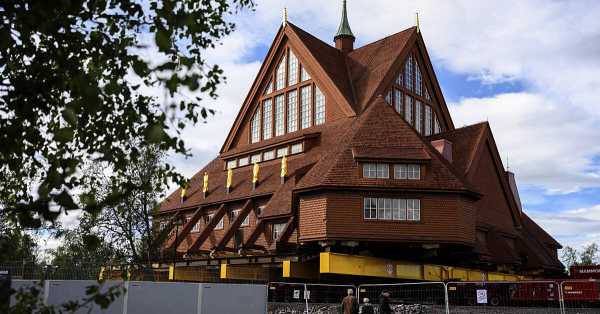
How to move one of Sweden’s most important wooden relics requires engineering savvy, spiritual support and a dash of Eurovision luck.
Kiruna Kirchen (Swedish: Kiruna Kyrka) and its bell tower are currently being moved along a 5 km (3 mi) route to the east, to the renewed centre of the city, which is undergoing a major relocation.

The largest underground iron ore quarry on the planet threatens to swallow up a populated area, forcing the relocation of architectural objects to another area.
Thousands of travellers have arrived in Kiruna, Sweden’s northernmost city, 200km (124 miles) from the Arctic Circle, this week.
It covers an area of 19,500 km² (7,528 sq mi) and is home to about 23,000 people, including the indigenous Sami people.

Priest Lena Tjarnberg launched the operation on Tuesday morning with a blessing ceremony.
The relocation of the temple is scheduled to be completed by Wednesday evening.
The event turned into a two-day spectacular project with the participation of King Carl XVI Gustaf, organized by the state-owned mining company LKAB.

The musical programme includes a performance by KAJ, the Swedish participant of Eurovision 2025, who bookmakers called the main favourite of the competition.
Kiruna and its surrounding area, famous for its midnight sun and northern lights, remain a magnet for tourists in Swedish Lapland.
However, not everyone supports LKAB’s initiatives.

Lars-Markus Kuokkanen, head of the Sami reindeer herding community, said LKAB’s expansion projects could disrupt reindeer seasonal routes and undermine traditional ways of life.
Preparations for the relocation of the Kiruna city centre have been underway since 2004.
The mine’s deepening to 1,365 m (4,478 ft) caused cracks to appear in the infrastructure, forcing the facilities to be moved to a safe area.

By July, 25 structures had already been moved on special platforms. There were 16 objects left in the queue, including the temple.
The temple, approximately 40 m (131 ft) wide and weighing 672 tons, required special preparation: widening the road from 9 to 24 m (30-79 ft) and dismantling the bridge structure.
The operator controls the movement via a large control panel. The process takes about 12 hours, with daily stops for fika, a Swedish coffee tradition.

Travel speed varies from 0.5 to 1.5 km/h (0.31 to 0.93 mph).
LKAB project manager Stefan Holmblad Johansson declined to disclose the operation’s budget.
Sourse: breakingnews.ie